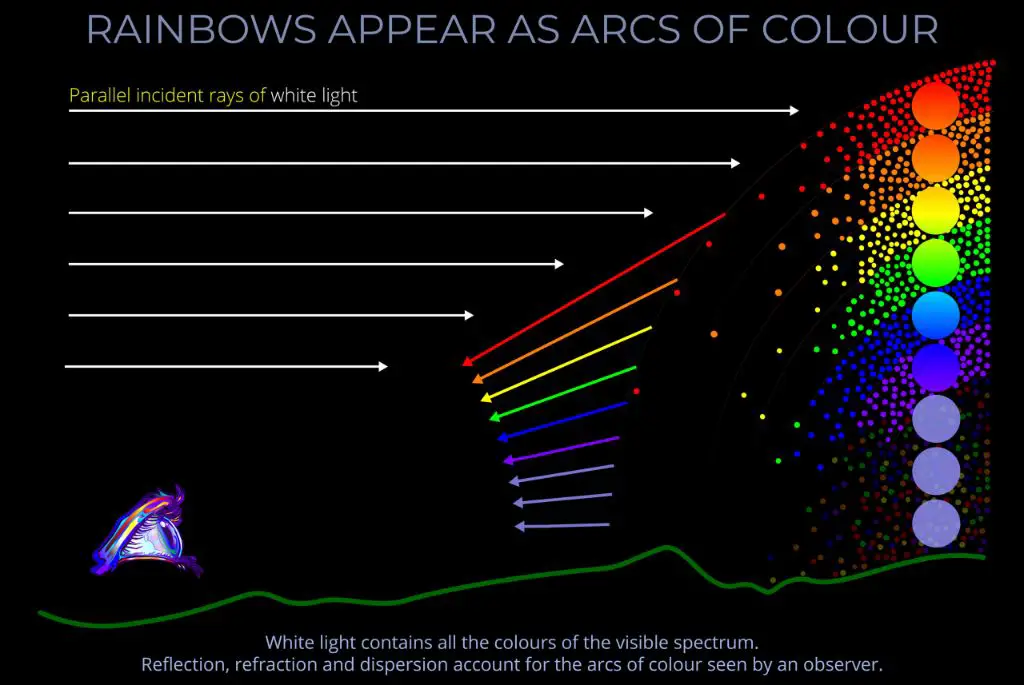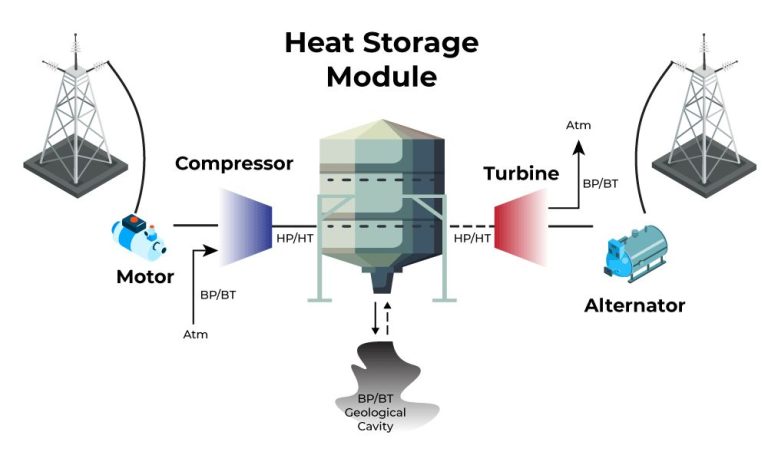What Are The Other Forms Of Radiant Energy?
Radiant energy refers to any energy that travels in the form of electromagnetic waves. The full range of radiant energies make up the electromagnetic spectrum. This spectrum is comprised of different types of radiant energy such as gamma rays, x-rays, ultraviolet light, visible light, infrared radiation, microwaves, and radio waves.
These different forms of radiant energy are distinguished by their wavelengths and frequencies. Gamma rays have the shortest wavelengths and highest frequencies, while radio waves have the longest wavelengths and lowest frequencies. In between these two extremes, the wavelengths get progressively longer and frequencies get progressively lower as you go from x-rays to ultraviolet light to visible light to infrared and microwaves.
While radio waves, microwaves, infrared radiation, visible light, ultraviolet rays, x-rays and gamma rays may seem very different, they are all related manifestations of electromagnetic energy. This brief introduction establishes the basics of radiant energy and the electromagnetic spectrum before diving into the specifics of each type of radiant energy.
Infrared Radiation
Infrared radiation, or infrared light, is electromagnetic radiation with wavelengths longer than those of visible light. It covers a range from roughly 700 nanometers, where it borders visible red light, to 1 millimeter. Infrared light has longer wavelengths than visible light, meaning it has lower frequency and lower energy. Though invisible to the human eye, infrared radiation can be detected as heat. Much of the thermal radiation emitted by objects near room temperature is in the infrared range.
Like all electromagnetic waves, infrared light has properties of both waves and particles. As waves, it can be reflected, refracted, and absorbed. As particles called “photons”, infrared radiation carries energy that is transferred when absorbed. Though less energetic than other forms of light, it can still initiate chemical reactions and damage materials and tissue. Infrared heating is a familiar example of how infrared radiation transfers energy.
Some major uses and applications of infrared radiation include:
- Thermal imaging – Infrared cameras can detect infrared radiation emitted or reflected from objects, producing images based on temperature variations.
- Night vision devices – Some use infrared illuminators to enhance viewing in low-light conditions.
- Tracking – Infrared homing systems are used to track targets and guide missiles.
- Astronomy – Infrared telescopes study celestial objects by the infrared radiation they emit.
- Heating – Infrared lamps, burners and lasers are used for industrial heating processes.
- Communications – Infrared data transmission is used in short-range communication and control systems.
- Spectroscopy – Materials can be identified by the unique way they interact with infrared radiation.
In summary, infrared radiation has a diverse range of properties and applications related to thermal effects and as a form of electromagnetic radiation just below the visible spectrum.
Visible Light

Visible light is the part of the electromagnetic spectrum that is visible to the human eye. The wavelengths of visible light range from about 380 to 740 nanometers. Visible light makes up a very small portion of the entire electromagnetic spectrum, which extends from radio waves to gamma rays.
The different colors we see result from lights of different wavelengths striking the retina in our eyes. Red has the longest wavelength while violet has the shortest wavelength. In between we see orange, yellow, green, and blue. When all the wavelengths are seen together, they make white light.
Visible light is incredibly important for life on Earth. It provides the energy that drives photosynthesis in plants and other organisms. Photosynthesis converts the sun’s light energy into chemical energy that nourishes the entire food chain. Visible light also provides the means for organisms to see and visually sense their environments. Our eyes have receptors that are sensitive to the different wavelengths of visible light.
In addition to photosynthesis and vision, visible light has applications in communications, optical technology, and more. Overall, the narrow band of visible light that the human eye can detect is essential for many critical processes on our planet.
Ultraviolet Radiation
Ultraviolet (UV) radiation is electromagnetic radiation with wavelengths shorter than visible light but longer than X-rays. UV radiation is present in sunlight and constitutes about 10% of the total electromagnetic radiation output from the Sun. There are three types of UV radiation – UVA, UVB, and UVC.
Properties: UV radiation has shorter wavelengths and higher frequencies than visible light. The wavelengths of UV radiation range from 10 nm to 400 nm. UVC has the shortest wavelengths (100-280 nm), while UVA has the longest (315-400 nm). UVB falls between UVC and UVA in wavelength (280-315 nm). Shorter wavelength UV rays have higher energy than longer wavelengths.
Sources: The Sun is the main natural source of UV radiation. Other sources include electric arcs, gas discharge lamps, black lights, and some lasers. Most UVC and some UVB radiation from the Sun is absorbed by the ozone layer in the atmosphere, but overexposure can still cause harm.
Effects: In small doses, UV radiation is beneficial, enabling the production of vitamin D. However, overexposure can cause various harmful effects. UVC radiation is very dangerous but completely absorbed by the ozone layer. UVB radiation causes sunburns and skin cancer. UVA radiation causes skin aging and wrinkling. UV radiation also affects the human immune system and damages DNA.
X-Rays
X-rays are a form of high energy electromagnetic radiation with very short wavelengths, typically between 0.01 and 10 nanometers. When X-rays pass through matter, they can penetrate it and expose the inside of objects. This makes them useful for a variety of medical and security applications.
One of the most common uses of X-rays is in medical imaging. Because bones and other dense tissues absorb X-rays more strongly than soft tissue, X-rays can create images that reveal bones, organs, and tumors inside the body. Doctors use X-ray imaging for broken bones, chest X-rays, mammograms, and CT scans.
In addition to medical uses, X-rays can also see inside luggage, packages, and shipping containers. Security personnel often pass these items through X-ray scanners to detect hidden contraband without having to open or damage the objects. The penetrating nature of X-rays allows screeners to see through concealing outer layers and find dangerous or illegal items.
While invaluable for these applications, X-rays also pose certain health risks. They can damage DNA and cause cancer with prolonged exposure. Lead shields and careful dosage control help mitigate these dangers when X-rays are used responsibly.
Gamma Rays
Gamma rays are known for being the most penetrating form of electromagnetic radiation. They have the shortest wavelengths but the highest photon energies of any wave in the electromagnetic spectrum.
Gamma rays are produced in nature from things like lightning and radioactive decay from cosmic rays. They can also be artificially produced from nuclear reactions, radioactive decay, and other high energy processes.
Some natural sources of gamma rays on Earth include radioactive decay of materials, cosmic rays, lightning, and sunlight. Artificial sources include x-ray tubes, nuclear explosions, particle accelerators, and industrial radioactive sources.
Due to their high energies, gamma rays have extremely high ionizing and penetrating abilities. They can pass completely through most materials, including the human body. Lead shielding of several feet is often required for protection from high intensity gamma radiation.
Microwaves
Microwaves are a form of electromagnetic radiation with wavelengths ranging from about one meter to one millimeter, which sits between radio waves and infrared radiation on the electromagnetic spectrum. Microwaves have a number of interesting properties and applications:
The primary properties of microwave radiation include:
- Microwaves can penetrate and pass through most non-conducting materials like plastic, paper, glass, and ceramic.
- They are reflected by metals.
- Microwaves cause dielectric heating in water and certain other molecules, which allows them to be used for cooking food quickly.
- Microwaves carry information for communications like radio, television, and wireless networks.
Some of the most common microwave applications include:
- Communications – Cellular networks, wireless internet, radar, radio astronomy and satellite communications operate using microwave transmissions.
- Heating & Cooking – Microwave ovens heat food rapidly by exposing it to microwave radiation that causes water molecules to vibrate, creating internal friction that heats the food.
- Medical & Industrial – Microwaves are used in cancer treatment, food processing, chemistry, and various industrial processes for rapid heating.
In summary, microwaves are incredibly useful electromagnetic radiation, allowing for unique heating and cooking abilities, as well as high-bandwidth wireless communications. Their properties and applications make microwave radiation an essential part of modern technology and infrastructure.
Radio Waves
Radio waves are a type of electromagnetic radiation with wavelengths in the electromagnetic spectrum longer than infrared light. The wavelengths of radio waves range from 1 millimeter to hundreds of kilometers. Radio waves have long wavelengths compared to other types of radiation. Long wavelength radio waves can pass through clouds, walls, and buildings, making them useful for communication, broadcasting, and applications like radio navigation and wireless networking.
One of the most common uses of radio waves today is in communications. Radio waves are used for radio broadcasting, television broadcasting, two-way radio systems like walkie-talkies, cell phones, and wireless networking. The ability of long wavelength radio waves to pass through buildings makes them ideal for broadcasting since the waves can travel long distances and penetrate structures. The long wavelength allows efficient transmission of information by encoding data onto carrier radio wave signals, a key part of radio communications technology. From broadcasting to scanning radio frequencies, the long wavelength nature of radio waves makes them exceptionally useful for transmitting information without needing wires or cables.
Terahertz Radiation
Terahertz radiation refers to electromagnetic waves with frequencies between 0.1 and 10 terahertz. This range falls between microwave and infrared radiation on the electromagnetic spectrum. Some key properties and applications of terahertz radiation include:
Properties
– Can penetrate many common materials like clothing, paper, cardboard, wood, masonry, plastic and ceramics. However, terahertz rays are blocked by conductors like metal and water.
– Non-ionizing radiation, meaning it does not have enough energy to ionize atoms and molecules like x-rays and gamma rays. Considered safe for human exposure at low levels.
– Sensitive to water content and polarization, allowing terahertz systems to distinguish differences in water density.
Emerging Applications
– Security screening – Can detect concealed explosives, weapons, and other threats obscured by clothing at airports and other high-security venues.
– Medical imaging and dentistry – Provides imaging of soft tissues without harmful ionizing radiation of x-rays. Useful for skin, breast and oral cancer screening.
– Manufacturing quality control – Used to detect cracks, voids and defects in products like pharmaceutical tablets, plastics, ceramics and foam insulation.
– Wireless communication – Ultra-high bandwidths may allow terahertz frequencies to transmit data faster than WiFi and 5G networks.
Conclusion
The electromagnetic spectrum encompasses all the various forms of radiant energy, ranging from radio waves on the long wavelength and low frequency end, up to gamma rays on the short wavelength and high frequency end. Understanding the full spectrum is crucial for harnessing these different types of radiation for practical applications that benefit humankind.
Each type of electromagnetic radiation has unique properties and behaviors that make it suitable for different uses. Radio waves, for example, allow for long distance communication, while infrared radiation is felt as heat. Visible light illuminates the world around us, ultraviolet light has medical uses, and x-rays allow us to peer inside the human body.
Studying and utilizing the entire electromagnetic spectrum has led to extraordinary breakthroughs in science, technology, medicine, communications, energy production, astronomy, and more. Continued research into all bands of radiation will open new frontiers of knowledge and innovation that can improve quality of life for all. The spectrum exemplifies how seemingly intangible waves of energy can have very tangible impacts on human civilization when properly understood and harnessed.







